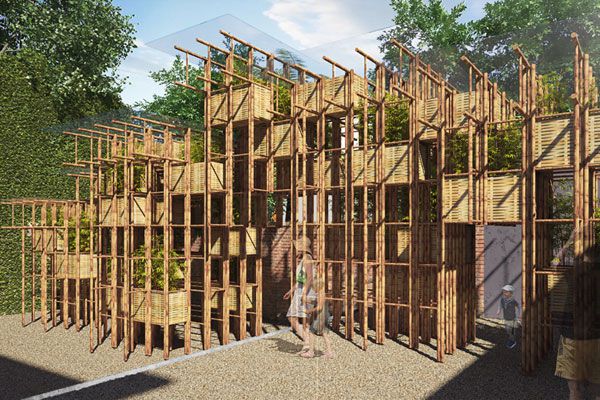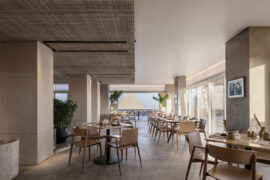The Sherman Contemporary Art Foundation’s (SCAF) Fugitive Structures 2016 pavilion, designed by Vo Trong Nghia, will be installed at the entrance to State Library of Queensland (SLQ), 1 March – 15 May 2016.

January 29th, 2016
Fugitive Structures 2016 is SCAF’s fourth iteration of the annual architectural pavilion series, aligning with Asia Pacific Architecture Festival’s aims to celebrate the diversity of the countries, cities and people of the Asia Pacific and to reflect on the way new world cities are responding to the opportunities and challenges of the Asian century through architecture.
Architects Vo Trong Nghia Architects (VTNA) have designed the pavilion, which will be constructed from simple bamboo ladders bound together to form a multi-tiered structure. The choice of Bamboo — the world’s fastest growing plant which is sustainable, lightweight and low maintenance — is a material perfectly aligned with VTNA’s environmental concerns.
Vo Trong Nghia is world-renowned for his work with bamboo and sustainable designs, and explores the lack of green spaces in urban environments, and the development of low-cost housing solutions for Vietnam’s poorest communities in his work. Vo has developed a sustainable architectural design practice by integrating inexpensive, local materials and traditional skills with contemporary aesthetics and modern methodologies.
SCAF brings his work to Australia for the first time. The 2016 pavilion by Vo Trong Nghia Architects marks the first Asia-based firm to design a pavilion for the SCAF series.
The structure will be installed from 1 March until 15 May 2016 at the State Library of Queensland in Brisbane, and then will relocated to SCAF’s outdoor courtyard in Sydney from 8 July until 10 December 2016.
Sherman Contemporary Art Foundation
sherman-scaf.org.au
INDESIGN is on instagram
Follow @indesignlive
A searchable and comprehensive guide for specifying leading products and their suppliers
Keep up to date with the latest and greatest from our industry BFF's!

A curated exhibition in Frederiksstaden captures the spirit of Australian design

Gaggenau’s understated appliance fuses a carefully calibrated aesthetic of deliberate subtraction with an intuitive dynamism of culinary fluidity, unveiling a delightfully unrestricted spectrum of high-performing creativity.
InterfaceFLOR draw upon a global resource bank of ideas to drive new design directions

Watch Bates Smart’s brand new Victorian Racing Club from the sky as the building’s shell is completed ahead of the Spring Racing season.

How do spaces for children differ from spaces for adults? Muxin Studio creates a cosy children’s library in Shanghai where fused spaces are comfortably scaled for little ones and choreographed to suit learning and play, introverted and extroverted activities.

How do our universities cater to education’s ‘new consumers’? That is 21st century students – new age info-natives who study, socialise and ‘hang’ in the spaces in-between home and the lecture theatre. RMIT’s New Academic Street is a radical re-make of a rapidly ageing campus, addressing changing student needs with a complex design scheme that puts the emphasis on technology and study.
The internet never sleeps! Here's the stuff you might have missed

Pedrali’s Nemea collection, designed by Cazzaniga Mandelli Pagliarulo, marks 10 years of refined presence in hospitality and commercial spaces around the world. With its sculptural timber form and enduring versatility, Nemea proves that timeless design is never out of place.

Melbourne is the destination and Saturday 6th September is the date – get ready for this year’s one-day design extravaganza with a full guide to what’s on.